#oil pigment limestone on canvas
Explore tagged Tumblr posts
Text
Françoise de Felice
Artist painter
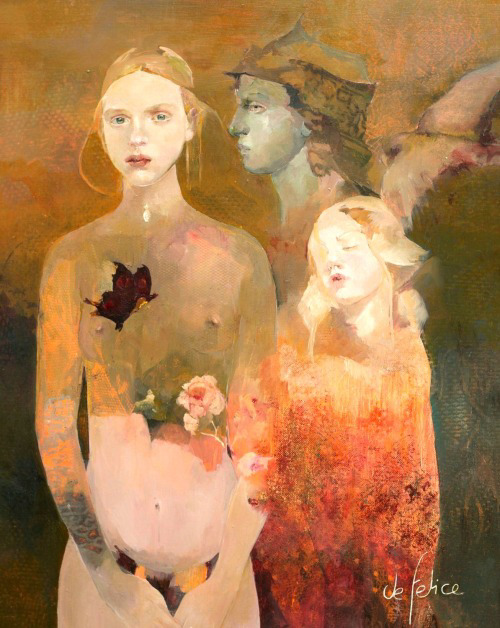
#françoise de felice#artist painter#original art#art#art style#artwork#colors art#women in art#pastel colors#naturar color canvas & oil#expressionism#oil pigment limestone on canvas#ooctoopussy#frank murdoff#xpuigc#xpuigc bloc
31 notes
·
View notes
Video
tumblr
🔨
• Sur la confection personnelle de mes supports / About the making process of my canvases. • La plénitude des étapes de réalisation ainsi répertoriées : - Assemblage Montage d'un châssis en croix composé de 6 traverses d'abiétacée {famille des résineux}. • - Tension Coutil de lin & coton, tendu après l'application d'un primaire {1 liant + 1 charge minérale} & le brossage/décatissage de la toile. • - Encollage Application d'une colle de peau {Gélatine de cartilages} chauffée au bain-marie pour une imperméabilisation de la toile au médium utilisé & une résistance des fibres de cette dernière à la siccativité de l'huile employée. Dose de 1 g pour 10 mL d'eau. • - Enduction Badigeonnage plus ou moins épais de la surface par un enduit de type "gesso" {1 colle +1 charge minérale (Traditionnellement calcaire)} Ici, 200 mL de colle de peau pour 3 cuillères à soupe de poudre de marbre & 1 de pigment. • 🇬🇧 • The full of the realization & steps listed as follows: - Assembly Installation of a cross frame consisting of 6 crossbars {softwood family}. • - Tension Linen & cotton seam, tensioned after application of a primer {1 binder + 1 mineral charge} & brushing/descaling of the canvas. • - Gluing Application of a skin glue {Cartilage gelatin} heated in a water bath for a waterproofing of the fabric to the medium used & a resistance of the fibers of the latter to the siccativity of the oil used. Dose of 1 g per 10 mL of water. • - Coating More or less thick coating of the surface by a "gesso" type coating{1 glue + 1 mineral charge (Traditionally limestone)} Here, 200 mL of skin glue for 3 tablespoons of marble powder & 1 of pigment. • • Rushes : Soany, Rémi, Élise 'n me. •
¡ 🤘 !
#handmade#handmade&craft#oilpainting#painter#artist#illustrator#visualdevelopment#artstation#figurativeart#contemporaryart#digitalart#glitchart#glitch#databending#finearts#moleskineart#moleskinesketch#sketches#sketchdaily#draw#drawdrawdraw#contemporaryartist
1 note
·
View note
Text
I know an Archaeologist who does all sorts of amazing work, including recording models of caves for mapping & virtual walk through, enhancing all varieties of their cave art (painted & carved) and wow, is it mind blowing.
Star Cave, Guam —
Link to 3D Model & Art enhancement :
youtube
Lions of Chauvet, Chauvet Cave, France:
Video of the actual panel, *not* the replica cave visited by tourists:
youtube
The 'hands cave' is literally named "The Cave of Hands (Cueva de Las Manos) and is in Argentina
https://whc.unesco.org/en/list/936/
Video of the art:
youtube
Cascadia Cave, Oregon USA
youtube
The oldest Petroglyphs in the US could be those in Nevada, dating at 10,000-14,000 years old —
Also in Nevada, Toquima Cave has several shades of pigments used in the pictographs on the rock outcropping :
Humans have taken pigment to stone and stone to stone to make marks both functional and beautiful. We moved on to barks, papers of reed and pulp, parchment, canvas and any medium that would take staining, even our own skin.
We discovered how to use light and shadow and oils and starches to capture images to share with others, to show them what our own eyes saw but what we were unable to draw ourselves.
Then we tamed electricity through several different formats to send words and images all around the world to again share our little parts of the world with other humans, to show what we find beautiful, to warn and to awe, to educate or amuse and to add to our communities from individual to entire.
There's something extremely human about finding a little spot and filling it with our own words and art, but even more human is that we share it: it isn't hidden away for ourselves alone. We chose the space and then choose what to share because we think it's helpful or beautiful or interesting and know that other humans love that.
@kaijuno your handprints adorn not only your own cave but thousands of others, and while they may not last 10,000 years they've already been seen by generations of other curious humans. They'll continue to be seen and shown in distant lands adorning the caves of strangers, and even better yet, inspire completely new arts and works that will also be seen. You'll never know the impact you'll truly have on the world, but I don't think the artists working lions and deer or handprints onto stone by firelight had any idea children 30,000 years later would be inspired to pick up mass-produced paper and fruit scrnted magic markers to copy their strokes and wondrously, magically, immediately find in those simple lines a lifelong love of art, either.
And yet. Here we are. Our handprints fit inside of theirs, and the generations to come will fit inside ours. We have been here. We are here. We are leaving a little digital mark in our little electric caves that are creating marks in our world, tangibly, when someone is inspired to laugh or cry or learn or help.
Your mark exists and expands every day. You're here and remembered and lovely.
🖐️
I'm v drunk and watching videos on how, prehistorically, humans cared for the injured and disabled, and it lead to disabled individuals living full lives whilst animals with similar injuries would have perished. And it makes me wanna cry so bad because humans are so inherently good? They're inherently kind? Humans want to care for one another. Prehistoric humans cared for their disabled. If you wanna think about humans in terms of numbers, if you think about "humans need x amount of food, so they need x amount of hunters and no room for slackers" it's WRONG. It's always been wrong. Humans share. Humans care about other humans. Humans sacrifice things to make other humans more comfortable. It makes me a dumb emotional baby thinking about how it's always been human nature to care about each other. It makes me think about how random acts of kindness make people feel so warm and fuzzy. It's because they're satisfying a primal need to care about others. Because that's what humans do
#Let's drink and talk about leaving our marks#The internet as the new caves#Our words as the new markings#Weepy and hopeful we slap our hands against these digital walls#I was here#You saw me#That's fucking beautiful#Drunk and wordy#Youtube
7K notes
·
View notes
Text
8 facts about pastel painting
8 facts about pastel painting
[ad_1] 1. Pastels are made from a secure base like all other fine art paints, including oils and acrylics. The difference is the binder. Pastels use very little binder, so it’s almost like applying direct pigment to a canvas.
The pastels are do notchalk! Chalk is made from limestone. Pastels are totally different. Pastels are one of the oldest and longest lasting foundations for hand painted…
View On WordPress
0 notes
Text
Pros and Cons of Linoleum Flooring

At a time when marble, ceramic and wooden flooring are considered to be the only viable options for homes in Pakistan, linoleum flooring remains pretty much forgotten and widely ignored. However, as interior designing experts have been pointing out, linoleum flooring has started getting popular once again – though for a different reason than what you might expect. When it comes to choosing flooring materials for home, most people prioritize aesthetics over everything else. Linoleum flooring may not be as aesthetically pleasing as synthetic carpet or vinyl flooring, but it is certainly a lot more eco-friendly and sustainable than most other options available in the market. So, if you want to adopt a sustainable lifestyle or want to make sure your house is free from toxic air pollutants, opting for linoleum is certainly one of your best bets. Let’s take a look at the pros and cons of linoleum flooring and tackle some of the major misconceptions about it. WHAT IS LINOLEUM FLOORING? Linoleum is one of the most environment-friendly flooring materials Linoleum is an all-natural flooring material that is made from solidified linseed oil, ground cork dust, pine resin, pigments, wood flour, and ground limestone on a canvas or burlap backing. Manufacturers usually add a protective layer on top of linoleum to prevent discolouration due to sunlight exposure and to prevent scratches. However, it’s not always present. Read the full article
0 notes
Text
10 of the best family-friendly hotels and villas in Greece | Travel
Sifnos, Cyclades
It’s rare to find a hotel that appeals to children of all ages. Verina Suites does so brilliantly, and has plenty of perks for adults too. Staff in white deliver homemade lemonade to the squishy day beds that line the turquoise pool. Kids can mess around on giant inflatables or play table tennis, while their parents wind down with outdoor yoga sessions or summery cocktails. Suites in sandy hues are set among fragrant gardens, with terraces where you can doze to the sound of the waves. Shallow Platis Gialos beach is across the road, with pedal boats, paddleboards and a lively strip of tables-in-the-sand tavernas and beach bars to choose from. • Doubles from €110 B&B in low season (fully booked in 2019 school summer holidays), kids up to 16 stay free in their parents’ room Getting there Five hours by ferry or three hours by catamaran from Athens
Lesvos, North Aegean
Every soothingly simple villa at Little Bird on the north coast of Lesvos has full-blown sea views. There are shady gardens, flagstone terraces for backgammon sessions as the sun sets behind the Byzantine castle of Molyvos and an infinity pool (and children’s pool) from which you might spot monk seals or flamingos. Skip down to Avlaki beach for a dip before breakfast at the Bird Café. Kids will love the fruit smoothie and home-made bougatsa (custard pie). Parents can while away the afternoon sampling the island’s most famous products: sardines, olive oil and ouzo. • From €90 a night (from €150 in high season) for a one-bedroom villa (sleeps three); €120 (€185 high season) for a two-bedroom villa (sleeps five), not including breakfast Getting there Thomas Cook charter flights from Gatwick, Manchester and Birmingham. From Athens, daily flights (50 minutes) with Aegean or Olympic airlines, or it’s 11 hours by ferry. Little Bird is 60km from the airport; car hire recommended
Arcadia, Peloponnese
The nine-suite Villa Vager guesthouse, owned by Nicholas and Marina Vager, is homely yet stately. Marina, an interior designer, created the handsome alpine vibe, softened with lace curtains and wildflower bouquets. She also makes the tastiest pies, cakes and pizzas, (served beside a roaring fire in winter) after a day hiking the Menalon trail or river rafting. Most rooms have stirring views of rolling plains and fir-clad mountains. It’s a great base for active families with older kids; Nicholas’s adrenaline-fuelled quad-biking tours will have teenagers raving. If you want to drag the kids around some ruins, it’s an easy day trip to Mycenae and Olympia. • From €120 a night for a room sleeping three (from €170 in high season), including breakfast Getting there An hour from Kalamata airport or a two-hour drive from Athens
Elounda Bay, Crete
This spot on the island’s north-east coast is a byword for super-luxe holidays. The laidback Elounda Island Villas, blissfully isolated on a tiny, sandy cove, are refreshingly unpretentious and affordable. The open-plan, solar-powered houses are the epitome of understated Greek island style: slate floors, built-in beds dressed in pure white, locally made pine furniture, and canvas chairs on verandas overlooking Spinalonga bay. Breakfast is served in an open-air snack bar, where you can while away the afternoon while the kids (who must be six and over) build sandcastles on the beach. Take older kids kayaking or snorkelling around the sunken ruins of Olous or rent a motorboat to explore Spinalonga island. The houses are self-catering, but there are seaside tavernas within strolling distance. • From €130 a night (from €150 in high season) for a two-bedroom maisonette for four to five Getting there Heraklion airport (an hour’s drive), is served by several flights a day from the UK (in season only) and Athens. The ferry from Piraeus to Heraklion takes five to eight hours
Evia
The 10,000-acre Candili Estate on the underrated (and Greece’s second largest) island of Evia, north-east of Athens, is part English country pile, part Greek history lesson. It’s been in the Noel-Baker family since Edward Noel, a relative of Lord Byron, bought the estate in 1832. Somehow, it has survived – a slightly threadbare but charming throwback, all sagging bookshelves, creaky wooden floors and hand-woven bedspreads. It’s the perfect setting for big family gatherings. The granary has been converted into 10 bedrooms overlooking a pool glittering in a glade. Also in the bucolic grounds is an icy plunge pool fed by a mountain spring, a ping-pong table, trampoline, and croquet lawn. Philip Noel-Baker, the puckish lord of the manor, encourages kids to pile into (and onto) his vintage Land Rover for off-road adventures. At dinner, everyone gathers around communal tables to swap stories over Stavroula’s wonderful Greek cooking. The whole place can also be rented as one, for up to 25 people. • Family weeks from €65 per adult, €40 per child (under 13) per night half-board and including snacks and drinks. Children under four stay free Getting there Two hours’ drive from Athens
Zagori, Epirus
Want to let your kids run amok in the wilderness? Zagori is just the ticket. This mainland region of soaring peaks, craggy gorges and rippling streams is gradually getting the attention it deserves thanks to lovely lodges like Astra Inn. Open year round, it’s in Megalo Papingo, one of 50-odd villages camouflaged in the hills. There are six wood and stone cottages and the cosy restaurant serves Greek comfort food (river trout, nettle pie, stuffed courgette blossoms) using ingredients reared, grown, or sourced locally by Kostas and Spyros Tsoumanis, brothers who will take you truffle or mushroom hunting in season. Tweens and teens can go wild swimming in rock pools, canyoning, rafting or hit the hills on ebikes. • From €100-€120 a night all summer, €15 per child, including breakfast Getting there Daily flights (45 minutes) from Athens to Ioannina, then one hour by car to Megalo Papigo
Laconia, Peloponnese
Surrounded by more than a thousand olive trees, Eumelia, a biodynamic farm, is sustainably minded and beautifully designed. The five guest cottages have dusky pink and ochre walls painted with natural pigments, beamed ceilings and geothermal heating. Activities change with the seasons: grape pressing, olive harvesting or cooking lessons using organic produce from the farm. Kids can help the owners, Frangiskos and Marilena, to feed the animals, plant vegetables and forage for the herbs that find their way into the wild asparagus omelette, lavender biscuits and fig and prickly-pear preserve served for breakfast. There are free mountain bikes if you want to explore Laconia’s towering mountains or serene coastline. • €160 a night for a family of four (kids under 12), including breakfast Getting there The closest airport is Kalamata (1¾ hours). It’s a 3½-hour drive from Athens
Chania, Crete
Ammos is the gift that keeps on giving for frazzled parents of babies and toddlers. Every year, the owner, Nikos Tsepetis, adds more designer – or as they put it “museum grade” – chairs (yes, every year they add a few new ones) and contemporary art to the all-white sunny living/dining room, more kid-friendly treats to the extravagant breakfast spread, more toys to the playroom and heated pool. After upgrading the rooms, this year he’s redesigned the lobby in undulating white marble. The jackpot: four hours of free childcare from Monday to Friday, leaving parents free to loll on the sandy beach below or have a massage. • From €125 a night in low season and €190 in high season (10% of the room rate for kids from two to 15; 5% for under-twos). Breakfast is €11 for adults and €7 for children aged two to 10 Getting there British Airways, easyJet, Ryanair and Norwegian operate direct flights to Chania (four hours); flights from Athens (55 minutes) with Aegean and Olympic airlines and Sky Express. Ammos is a 30-minute drive from Chania
Kardamyli, Peloponnese
Wedged between the Taygetos mountains and the Gulf of Messinia, the little seaside town of Kardamyli is where Patrick Leigh Fermor hung up his walking boots and laid down roots. Giorgos and Maria (who also run Fermor’s favourite taverna, Lela’s) have created the Notos Hotel, a cluster of stone apartments and studios tumbling down the hillside above the town. Open all year, the plain but spotless houses make a handy base for exploring the medieval castles, limestone gorges and shingle coves of the outer Mani. You’ll need to make (or pre-order, for an extra charge) your own breakfast and there’s no full-time staff on site. But Giorgos and Maria will point you in the direction of all the best local secrets. • From €100 a night (from €160 high season) for an apartment sleeping four, not including breakfast Getting there Thomas Cook, easyJet, BA and Aegean fly to Kalamata, an hour’s drive away. Car hire recommended
Syros, Cyclades
For Nick and Elspeth Geronimos, the Good Life is all about the humble pleasures that drew tourists to Greece before package holidays and fancy resorts. They have restored a smattering of 200-year-old cottages on Syros, an island with a lively year-round population and cultural scene. Surrounded by olive groves and vineyards, the self-catering houses are off-grid but brim with thoughtful features for families: washing machines, barbecues, filtered drinking water, baby equipment and kids’ bikes. You can help yourself to eggs, vegetables and fruit from the garden. It’s a five-minute stroll to peaceful Voulgari beach – ideal for toddlers. Older children can learn to sail or go pony riding. • From €90 a night for a villa that sleeps 4 (from €210 in high season), not including breakfast Getting there Ferries depart from Piraeus, Lavrio and Rafina to Syros (3 to 3½ hours); daily flights from Athens (35 minutes)
Looking for a holiday with a difference? Browse Guardian Holidays to see a range of fantastic trips
The post 10 of the best family-friendly hotels and villas in Greece | Travel appeared first on Tripstations.
from Tripstations http://bit.ly/2IbzLTh via IFTTT
0 notes
Text
8 Pastel Painting Facts
8 Pastel Painting Facts
[ad_1] 1. Pastels are made from the safe base as all other fine art paints, including oils and acrylics. The difference is the binder. Pastels use very little binder so it is almost like apply direct pigment to canvas. 2. Pastels are not chalk! Chalk is made from limestone. Pastels are totally different. Pastels are one of the oldest and most enduring foundations for hand painted portraits. 3.…
View On WordPress
0 notes
Text
Dillon Samuelson
Phantom Limb
oil on canvas
18 x 28"

#dillon samuelson#phantom limb#oil on canvas#18 x 28#artist painter#original art#art#art style#artwork#colors art#women in art#lansdcape art nature#naturar color canvas & oil#nature colors#chalk pastel#oil pastel#watercolor art#oil pigment limestone on canvas#oil on panel#oil canvas#art colors#ooctoopussy#xpuigc#xpuigc bloc
24 notes
·
View notes
Text
Hope Gangloff

#Hope Gangloff#artist painter#original art#art#art style#artwork#colors art#women in art#art work#art by women#oil pigment limestone on canvas#naturar color canvas & oil#watercolor art#oil on canvas#nature colors#art colors#ooctoopussy#alfhild algotsson#frank murdoff#xpuigc#xpuigc bloc
17 notes
·
View notes
Text
Rudolf Nikolaevich Baranov
From the height of the port crane
1974

#rudolf nikolaevich baranov#From the height of the port crane#1974#artist painter#original art#art#art style#artwork#colors art#women in art#lansdcape art nature#naturar color canvas & oil#art colors#pastel colors#art gallery#oil on canvas#art work#art contemporain#oil pigment limestone on canvas#art illustration#watercolor art#oil pastel#classic art#ooctoopussy#xpuigc#xpuigc bloc
15 notes
·
View notes
Text
Michele Mikesell

#michele mikesell#artist painter#original art#art#art style#artwork#colors art#women in art#oil pigment limestone on canvas#naturar color canvas & oil#art colors#oil pastel#ooctoopussy#xpuigc#xpuigc bloc
16 notes
·
View notes
Text
ヌーヌ|nuunu



#ヌーヌ|nuunu#artist painter#original art#art#art style#artwork#art gallery#art work#contemporary japanese art#artist japanese#japan art#japanese artist#japanese culture#paiting illustrator art#paintinting illustration art#oil pigment limestone on canvas#naturar color canvas & oil#pastel colors#colors art#women in art#rabbids#oil pastel artwork#japanese graphic design#sai aeko#ooctoopussy#xpuigc#xpuigc bloc
10 notes
·
View notes
Text
Katerina Belkina

#katerina belkina#artist painter#original art#art#art style#artwork#colors art#women in art#naturar color canvas & oil#natural hair#oil pigment limestone on canvas#art colors#ooctoopussy#xpuigc#xpuigc bloc
9 notes
·
View notes
Text
Cynthia Ablicki
American landscape painter

#Cynthia Ablicki#American landscape painter#artist painter#original art#art#art style#artwork#art gallery#colors art#women in art#naturar color canvas & oil#lansdcape art nature#american artist painter#american art#american artists#american illustration#art work#art colors#art contemporain#oil pigment limestone on canvas#acrylic on canvas#pastel colors#watercolor art#ooctoopussy#xpuigc#xpuigc bloc
9 notes
·
View notes
Text
quentin monge
Beach Boy
oil, pigment limestone on canvas
80x100cm.

#quentin monge#Beach Boy#oil pigment limestone on canvas#80x100cm.#artist painter#original art#art#art style#artwork#colors art#beautiful beach#naturar color canvas & oil#art colors#ooctoopussy#xpuigc#xpuigc bloc
10 notes
·
View notes
Photo
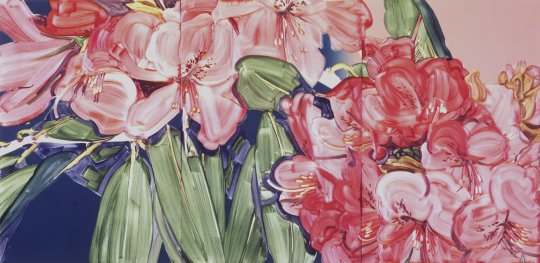
Springtime in Brooklyn by Nancy Rosoff, Andrew W. Mellon Senior Curator, Arts of the Americas
As I look out my window at the falling rain, I know that these April showers will soon be followed by May’s flowers. The vibrant colors of budding trees and blossoming flowers give us hope that we will overcome the current crisis, and the world will be rejuvenated, stronger, and more unified. The following works from the Brooklyn Museum’s diverse collection celebrate the arrival of Spring and our hope for a healthy and more peaceful world.
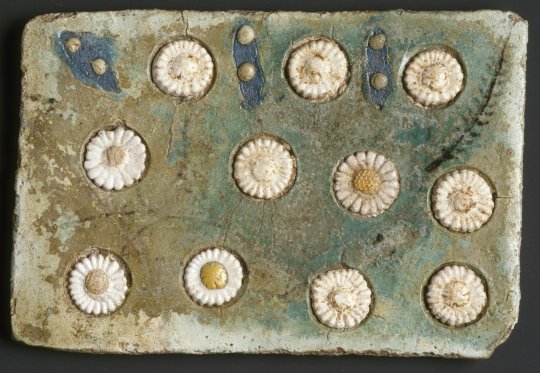
Brightly colored plants and flowers made of faience once decorated the walls of the Great Palace of king Akhenaten at Amarna. Sun light and the disk of the sun itself became the focus of religious worship in the Amarna period (1353-13336 B.C.E.). The floral motifs of these tiles were meant to evoke rebirth of life brought about by the sun. See the artwork in our open collection.

While the Nile was revered as a life-giving place, the desert was also teeming with nature. Here one can see animals breeding in their desert environs. To the right, a feline is showing interest in another feline. At the lower left, a male antelope, mounting his mate, rears his head into the row above. At the lower right, the hindquarters of an antelope giving birth and the emerging head of her calf are partly preserved. The bovine calf at center left completes this depiction of the cycle of life. See the artwork in our open collection.
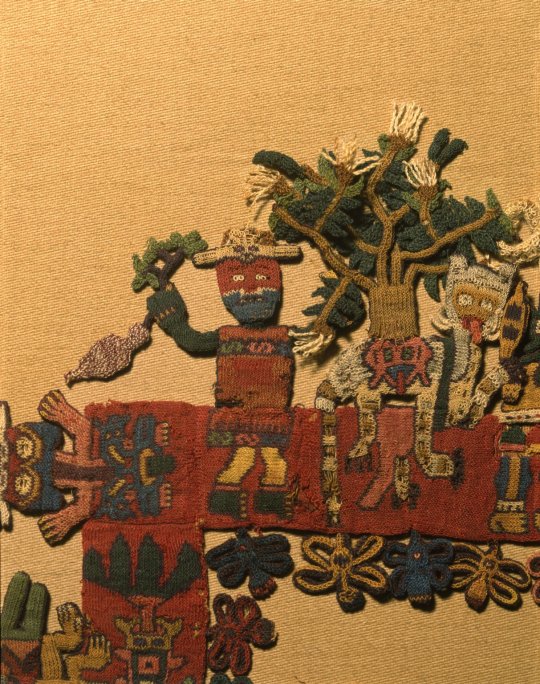
This detail from a Nasca mantle not only illustrates some of the plants and animals native to Peru’s South Coast, but it also conveys how the society’s spiritual beliefs are connected to agricultural seasons. The blossoming huarango tree seen here represents life and is shown growing out of a human trophy head on the back of a pampas cat. The trophy head symbolizes death but it is also a germinating seed from which life sprouts in a never-ending cycle of life, death, and rebirth. See the artwork in our open collection.
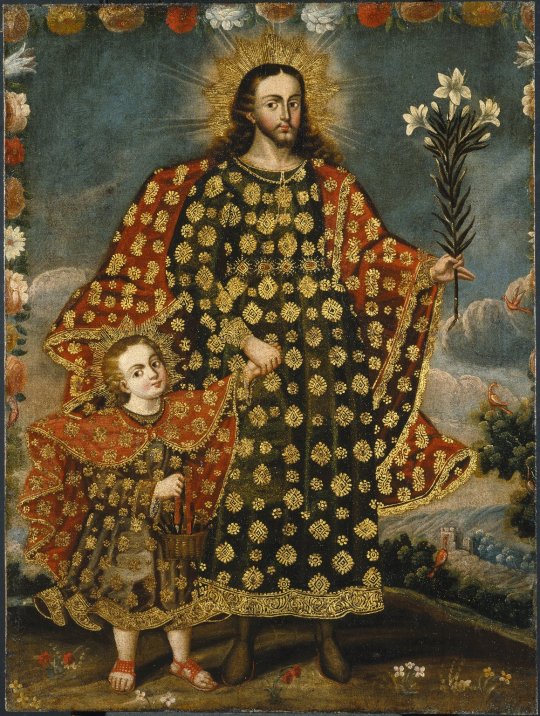
This late-seventeenth-century painting from viceregal Peru shows Saint Joseph standing hand-in-hand with the Christ Child in a field of blooming flora and enclosed within a border of bright carnations and lilies. Saint Joseph’s popularity flourished at this moment in the Spanish Americas as he embodied ideals of fatherhood, marriage, divinity, and masculinity. Here, he holds a stem of white lilies, which symbolize his holiness and purity. See the artwork in our open collection.
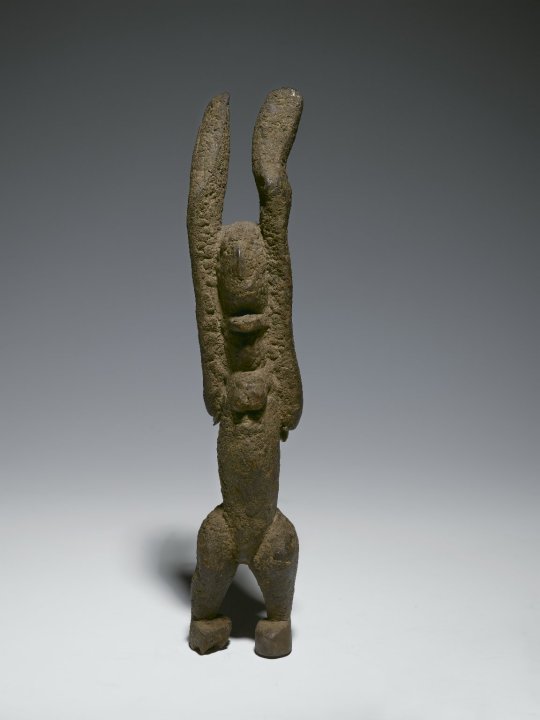
This sculpture would have served as a means for people to contact spiritual intermediaries for aid. Its raised arms are said to refer to prayers for rain, crucial to survive and thrive in arid the Mopti Region of Mali. See the artwork in our open collection.

The use of naturalistic floral motifs, such as carnations, tulips, and hyacinths, was a trademark of the design workshop of the Ottoman court in Istanbul in the mid-sixteenth century. This design principle was adopted in central and distant areas of the empire and applied to different media, such as manuscript illuminations made in Istanbul, textiles made in Bursa, and tiles made in Iznik and Damascus. This octagonal tile from Syria brings the beauty of spring indoors permanently. See the artwork in our open collection.

Vibrant greens and blues bring a spring woodland scene inside the Museum, creating an eternal verdant landscape. The effects of changing sunlight or a passing cloud can animate the glass used to depict the stream, tree trunks and leaves. Originally installed in the Universalist Church of Our Father at Classon and Atlantic Avenues in Brooklyn, the windows were purchased by the All Souls Universalist Church on Ocean Avenue and installed in 1945, before coming to the Brooklyn Museum a few years ago. Tiffany Studio was extremely skilled at creating panoramas that open onto lush, brilliantly colored vistas. See the artwork in our open collection.
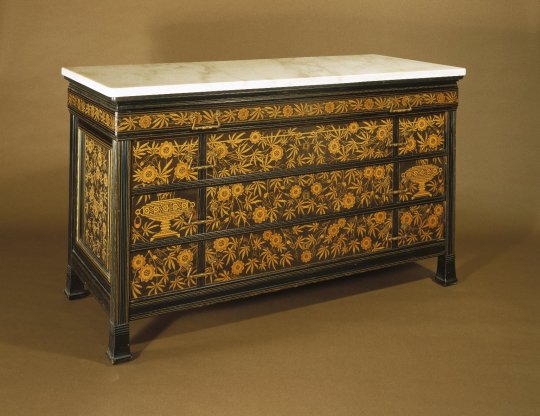
This elaborately decorated cabinet brought ever-blooming flowers into the owner’s bedroom. Inspired by Japanese precedents, New York’s most important late-19th-century furniture manufacturing firm Herter Brothers employed different colored woods to create the densely packed, abstracted flowers and leaves on this luxurious, yet functional chest-of-drawers. See the artwork in our open collection.

In the Japanese tradition, cherry blossom season is a time for celebration: the world wakes up after a long winter and people head outside to gather under the pink-and-white canopies created by trees that seemed barren only a week or two earlier. This year the picnics were cancelled, but in nature the show goes on whether there’s an audience or not. See the artwork in our open collection.
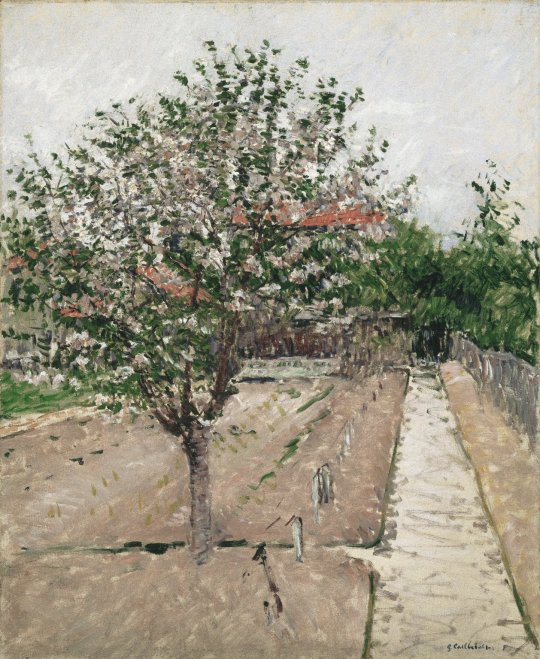
In this painting, Gustave Caillebotte offers a glimpse of his private garden in Petit Gennevilliers, a small village on the Seine opposite Argenteuil. The apple blossoms are rendered in thick touches of paint, which contrast with the sketchy treatment of the path that leads toward the denser foliage beyond the tree. See the artwork in our open collection.
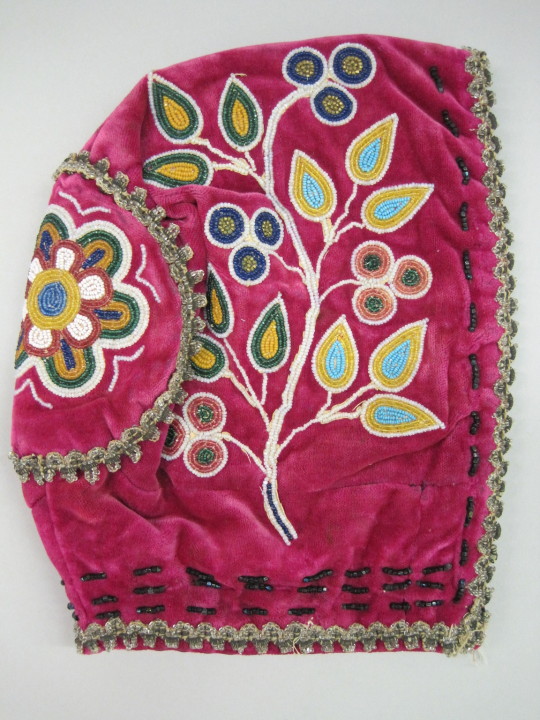
Nothing celebrates Spring more than this dazzling child’s cap with its delicate beadwork on vibrant rose-colored velvet. It was lovingly made by the mother or female relative of a little girl who would have worn it with pride during special occasions. See the artwork in our open collection.
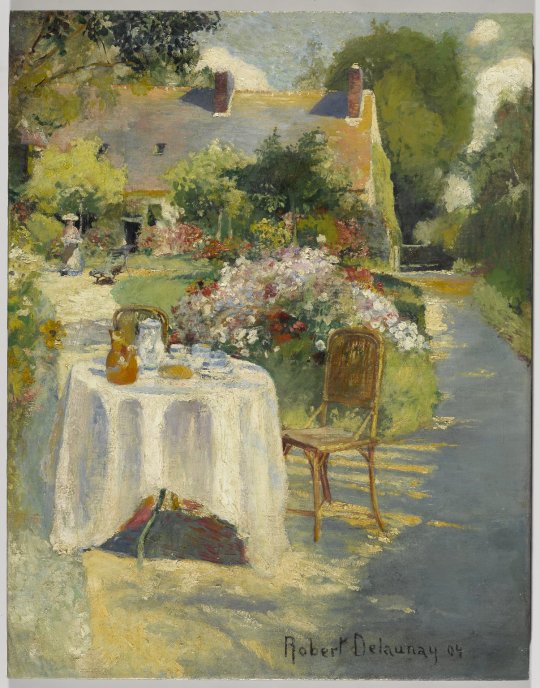
A table set with bread and coffee in a blooming garden along a sun-dappled path conjures the pleasures of the warmer months to come. Robert Delaunay would become known later in his career for more abstract work, but in this early painting the 19 year old artist was still working under the influence of Impressionism. See the artwork in our open collection.
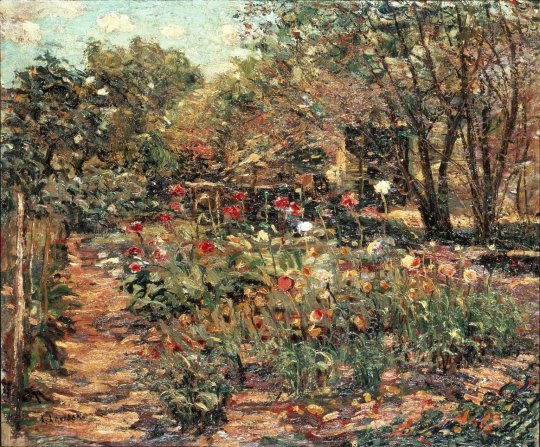
Redolent with the sweet scent of peonies, American Impressionist Ernest Lawson paints his flowerbeds in a dazzling display of jewel like tones in the Cos Cob art-colony located along the Connecticut shore. See the artwork in our open collection.
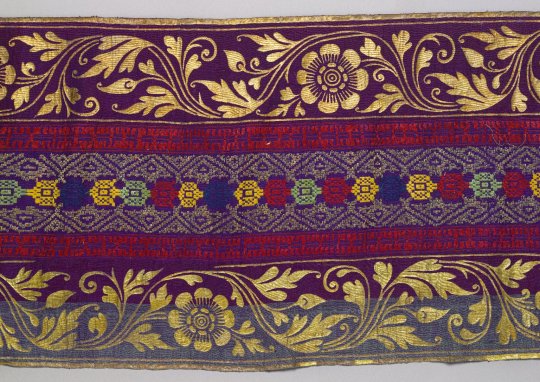
This Balinese cover features bright brocade rosettes in purple, blue, red, yellow, and green. The gilded gold overpaint features patra cina designs borrowed from Chinese floral patterns. Together, they create a glittering textile that is awash with color and floral motifs. See the artwork in our open collection.

One of the Brooklyn Museum’s most important Japanese paintings is a folding screen showing a group of urbanites walking together, followed by a musician and a servant with a big box. The only clue that they are heading to a cherry-blossom-viewing picnic comes from a woman who extends a branch of flowering cherry back toward a group of men. Attached to the branch is a long strip of paper of the type used traditionally in Japan for writing poems. What does the poem strip say? We don’t know, but it seems fair to guess that it serves as an invitation to romance. The screen reminds us that the spring tradition of partying beneath the cherry trees wasn’t solely about communing with nature. See the artwork in our open collection.

Inspired by Japanese folding screens or byōbu, Elizabeth Boott Duveneck’s five panels bring the natural world into the interior of the house depicting all four seasons from Autumn Foliage to Apple blossoms throughout the year. See the artwork in our open collection.

Beginning in the early 1930s, Consuelo Kanaga became one of few white photographers to make artistic portraits of Black Americans. This closely cropped and sharply focused image of a girl’s face with a flower was likely included in Group f.64’s inaugural exhibition in 1932, which announced a new realist direction in photography. Considered radical in its time, Frances with a Flower explores powerful ideas about beauty, gender, and race. See the artwork in our open collection.
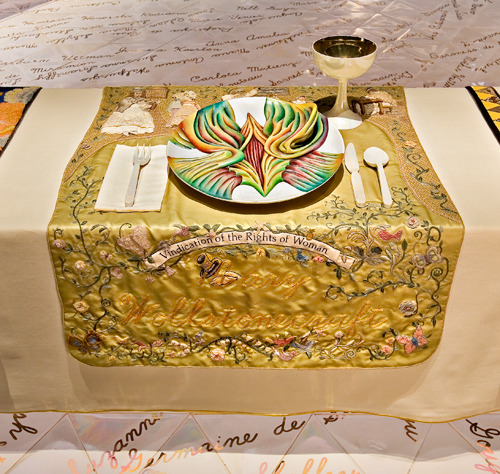
Mary Wollstonecraft was a renowned women’s rights activist who authored "A Vindication of the Rights of Woman," (1792), a classic of rationalist feminism that is considered the earliest and most important treatise, advocating for equality and education for women. Akin to the nature of Spring, Wollstonecraft's life symbolized the fruition of a legacy—from which infinite linages of women continue to reap the fruits of her labor. See the artwork in our open collection.
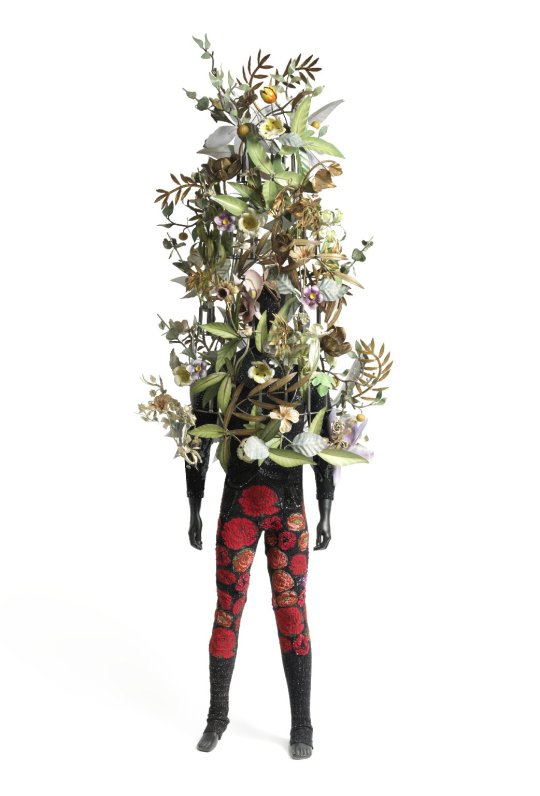
With rose-patterned leggings and an elaborate floral armature/headdress, Nick Cave’s Soundsuit transforms the human body into a lush garden. Since the early 1990s, Cave has been fabricating inventive sculptures out of scavenged materials, which he often overlays with beadwork, stitching, and other embellishments. One of the first, crafted from twigs, was made to be worn and created a rustling sound, which led to the eventual name of such works: Soundsuits. Cave’s costumes draw from a variety of sources, including both African and Caribbean traditions of masquerade. See the artwork in our open collection.
Posted by Nancy Rosoff with contributions from the Curators and Curatorial Assistants of African, American, Ancient Egyptian, Arts of the Americas, Asian, Contemporary, Elizabeth A. Sackler Center for Feminist Art, and Islamic Art
Photos: Gary Alan Bukovnik (American, born 1947). Rhododendrum, 1980. Lithograph on paper. Brooklyn Museum, Gift of the artist, 81.15.2. © Gary Alan Bukovnik(Photo: Brooklyn Museum); Tile with Floral Inlays, ca. 1352-1336 B.C.E. Faience. Brooklyn Museum, Gift of the Egypt Exploration Society, 35.2001. Creative Commons-BY (Photo: Brooklyn Museum); Relief with Desert Scene, ca. 2472-2455 B.C.E. Limestone, pigment. Brooklyn Museum, Charles Edwin Wilbour Fund, 64.147. Creative Commons-BY (Photo: Brooklyn Museum); Nazca. Mantle ("The Paracas Textile"), 100-300 C.E. Cotton, camelid fiber. Brooklyn Museum, John Thomas Underwood Memorial Fund, 38.12; Cuzco School. Saint Joseph and the Christ Child, late 17th-18th century. Oil on canvas. Brooklyn Museum, Museum Expedition 1941, Frank L. Babbott Fund, 41.1275.191 (Photo: Brooklyn Museum); Dogon. Nommo Figure with Raised Arms, 11th-15th century (possibly). Wood, organic sacrificial material. Brooklyn Museum, The Adolph and Esther D. Gottlieb Collection, 1989.51.39. Creative Commons-BY (Photo: Brooklyn Museum); Octagonal Tile Depicting Peacock in Prunus Tree, 16th century. Ceramic; fritware, painted in black, cobalt blue, green, and manganese purple under a transparent glaze. Brooklyn Museum, Gift of Jack A. Josephson, 1990.21. Creative Commons-BY (Photo: Brooklyn Museum); Tiffany Studios (1902-1932). Dawn in the Woods in Springtime, 1905. Stained glass window. Brooklyn Museum, Gift of All Souls Bethlehem Church, 2014.17.1. Creative Commons-BY; Herter Brothers (American, 1865-1905). Chest-of-Drawers, ca. 1880. Ebonized cherry, other woods, modern marble top, brass. Brooklyn Museum, Modernism Benefit Fund, 1989.69. Creative Commons-BY (Photo: Brooklyn Museum); Utagawa Hiroshige (Ando) (Japanese, 1797-1858). Suijin Shrine and Massaki on the Sumida River (Sumidagawa Suijin no Mori Massaki), No. 35 from One Hundred Famous Views of Edo, 8th month of 1856. Woodblock print. Brooklyn Museum, Gift of Anna Ferris, 30.1478.35 (Photo: Brooklyn Museum); Gustave Caillebotte (French, 1848-1894). Apple Tree in Bloom (Pommier en fleurs), ca. 1885. Oil on canvas. Brooklyn Museum, Bequest of William K. Jacobs, Jr., 1992.107.2 (Photo: Brooklyn Museum); Woodlands. Child's Cap, ca. 1890s. Velvet, cloth, beads. Brooklyn Museum, Gift of the Edward J. Guarino Collection in memory of Josephine M. Guarino, 2016.11.2. Creative Commons-BY; Robert Delaunay (French, 1885-1941). In the Garden (Dans le jardin), 1904. Oil on canvas. Brooklyn Museum, Gift of Iris and B. Gerald Cantor, 86.28 (Photo: Brooklyn Museum); Ernest Lawson (American, 1873-1939). Garden Landscape, ca. 1915. Oil on canvas. Brooklyn Museum, Bequest of Laura L. Barnes, 67.24.10 (Photo: Brooklyn Museum); Cover, 19th or early 20th century. Silk, pigment. Brooklyn Museum, Dick S. Ramsay Fund, 45.183.110. Creative Commons-BY; Cherry Blossom Viewing Picnic, ca. 1624-1644. Ink, color and gold leaf on paper. Brooklyn Museum, Gift of Frederic B. Pratt, 39.87. Creative Commons-BY (Photo: Brooklyn Museum); Elizabeth Boott Duveneck (American, 1846-1888). Apple Blossoms, 1882. Oil on wood panel. Brooklyn Museum, Gift of Joan Harmen Brown, Mr. and Mrs. William Slocum Davenport, Mrs. Lewis Francis, Samuel E. Haslett, William H. Herriman, Joseph Jefferson IV, Clifford L. Middleton, the New York City Police Department, Mrs. Charles D. Ruwe, Charles A. Schieren, the University Club, Mrs. Henry Wolf, Austin M. Wolf, and Hamilton A. Wolf, by exchange, Frank Sherman Benson Fund, Museum Collection Fund, Dick S. Ramsay Fund, Carll H. de Silver Fund, John B. Woodward Memorial Fund, and Designated Purchase Fund , 2005.54.3 (Photo: Brooklyn Museum); Consuelo Kanaga (American, 1894-1978). Frances with a Flower, early 1930s. Gelatin silver photograph. Brooklyn Museum, Gift of Wallace B. Putnam from the Estate of Consuelo Kanaga, 82.65.10 (Photo: Brooklyn Museum); Judy Chicago (American, b. 1939). The Dinner Party (Mary Wollstonecraft place setting), 1974–79. Mixed media: ceramic, porcelain, textile. Brooklyn Museum, Gift of the Elizabeth A. Sackler Foundation, 2002.10. © Judy Chicago. Photograph by Jook Leung Photography; Nick Cave (American, born 1959). Soundsuit, 2008. Mixed media. Brooklyn Museum, Mary Smith Dorward Fund, 2009.44a-b. © Nick Cave (Photo: Image courtesy of Robilant Voena)
#virtualtour#springtime#spring#brooklyn museum#museums#brooklyn#virtual tour#art#art museum#bkmtours#virtual tours
570 notes
·
View notes